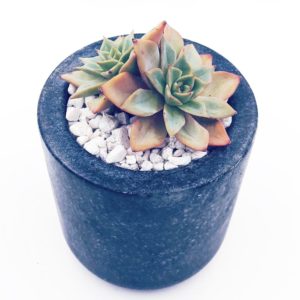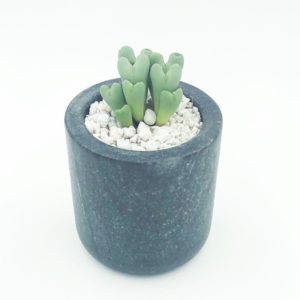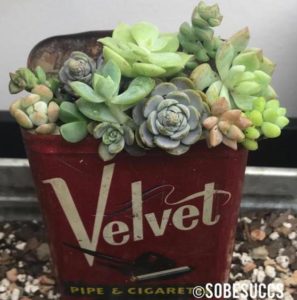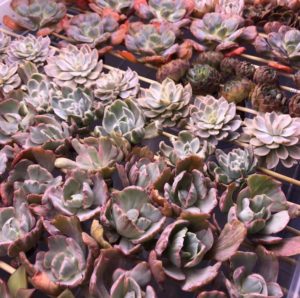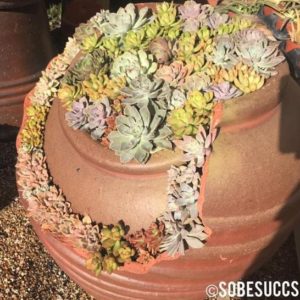Root Rot Troubleshooting
If you notice a succulent’s root/stem becoming increasingly dark in color and/or becoming soft, your plant may be developing root rot. If root rot has begun to develop, in addition to becoming darker in color, the root/stem will become squishy (and will even develop a unique smell). If this occurs, take your succulent off of the soil/potting mix and skip a watering or two.
In order to further prevent the spread of root rot, you may want to remove the affected leaves at the bottom of the plant, if any, and cut the stem above where any active root rot exists.
At this point, the best course of action is to step back and let nature take its course, but don’t replant you succulent immediately. Remember to always let any freshly-trimmed plants callous over before repotting or watering, regardless of the situation. If all goes well, you’ll get to see your succulent surgery skills pay off when new roots begin to form, your succulent begins to grow once again, and the root rot is a thing of the past!
Succulent Plant Club
Life’s full of hard choices, but deciding which plants to order doesn’t need to be one of them. By joining our monthly Plant Club, you’ll receive a variety of handpicked rare and imported succulents delivered straight to your door. You’ll never receive the same plant twice within the same calendar year), and, as a member, you’ll get first access to new inventory, special offers, and will receive a number of exclusive plants that we’re not otherwise making available in the shop. Our plant club is $39.99 per month for three plants each month or $69.99 per month for six plants each month, including shipping.
Plant Club shipments will ship on the first business day of each month beginning in November. Plant Club memberships are available as either six-month or annual contracts and may also be given as gifts.
Potting Mixes
Some say the easiest way to kill a succulent and/or cactus is by overwatering. While this is true, our experience suggests that fast-draining potting mix is at least as important as (if not more so than) avoiding overwatering. In fact, choosing the proper potting mix will actively reduce the risk of root rot from overwatering. A good rule of thumb is that if you grab your potting mix and clench your fist, the potting mix should fall from your hand once you unclench your first. There are many different varieties to choose from, and we’ve seen may different potting mixtures work well. Below we’ve described two of our favorite homemade mixes.
Homemade Potting Mix 1
One of the more popular and most economical soil solutions is to mix standard soil (make sure the soil does not have peat moss) with perlite and sand. As a general rule, the mix should be 50% soil, 25% perlite, and 25% sand. You can play around with the mixture and see how it feels and monitor how quickly it drains.
Homemade Potting Mix 2
Another good potting mix that can be made at home is equal parts (i) finely ground pine bark, (ii) a small clay-like material, and (iii) finely ground granite, lava, etc.
Water Therapy
In our opinion, water therapy is the most helpful and beneficial trick you can use with succulents. Surprisingly, even though succulents can’t spend extended periods of time in wet potting mix, their roots can be suspended in water to quickly address a multitude of issues that can impact succulents.
What’s Water Therapy?
Water therapy is the practice of allowing a succulent’s bare roots to remain submerged in water. Think of watering your succulent normally as drinking a glass of water, and think of water therapy as your succulent taking shots of water. Water therapy is the fastest way to rehydrate succulents (especially after shipping) and quickly develop roots.
It’s important to make sure only the bottom of the roots and/or stem are submerged and that any recently trimmed cuttings callous over before water therapy.
The most common way to create a vessel for water therapy is to fill a cup or shot glass (depending on the size of the succulent) with water so that the roots of the plants are submerged slightly.
Plants Get Tans, Too …. Kind of
Just like us, a plant’s appearance can change depending on factors such as sunlight and stress. Unlike us, plants tend to get far more attractive when stressed. If you notice your plant looking a little different than before, or if you recently ordered plants and they looks slightly different than the photo(s), it can most likely be attributed to stress and/or sunlight.
Stress
Succulents experience stress for a number of reasons, including infrequent or conservative waterings, exposure to colder-than-normal temperatures, shipping, repotting, etc.
When your succulent is slightly water deprived or has recently been exposed to cool weather, it will typically bring out the brightest and most vibrant colors on your plant. For example, if you leave a pink echeveria outside on a 50°F day, that same echeveria will be a much brighter pink than it would be on an 80°F day. The same pink echeveria would have a similar reaction to doubling the amount of time between waterings.
Sunlight
In order for your succulent to maintain the correct color, it needs to receive the correct amount of sun exposure. If your plant isn’t receiving enough sun, its color will generally be duller than normal. On the other hand, when a succulent receives slightly more sun exposure, this can bring out the deeper, richer tones of the plant. If your plant begins receiving too much light, you’ll be able to see what looks like bleaching of the leaves or even sun spots. If you notice your plants look like they’re receiving too much light, move them to a location with less direct sunlight.
In both scenarios, the color(s) of the plant can revert back to their original lightness, so the visible changes are not necessarily permanent.

